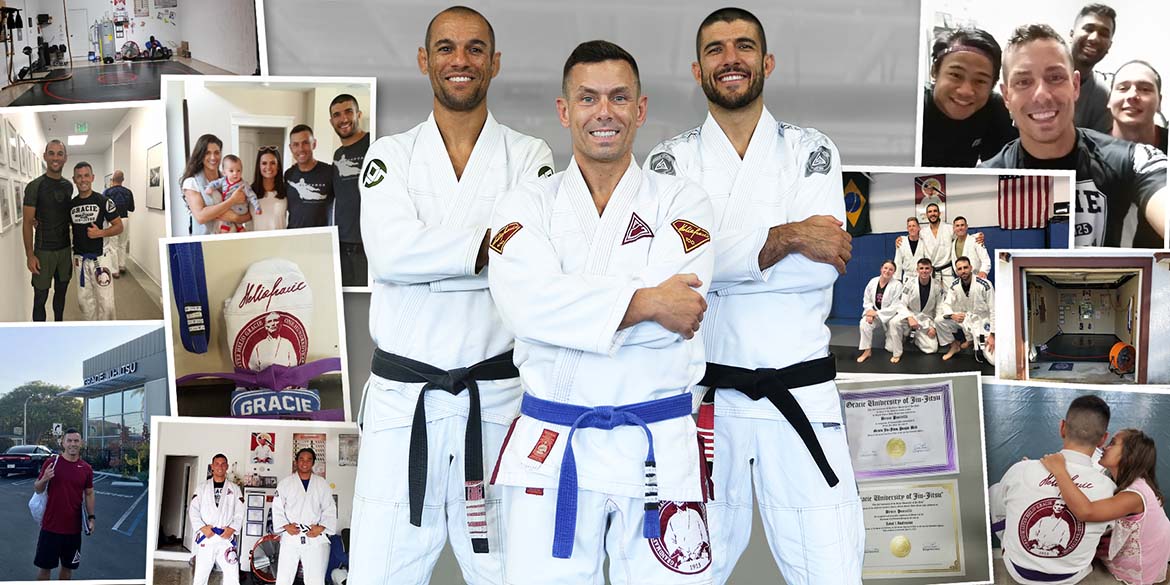
Bruce Porcelli is a Senior Network Engineer from Long Island, New York, who became fascinated with jiu-jitsu after witnessing its effectiveness in the early UFCs. After trying out a few BJJ schools, he became frustrated with the lack of curriculum structure and disproportionate emphasis on sport jiu-jitsu instead of self-defense. Just before he gave up on jiu-jitsu altogether, he learned about the Gracie Bullyproof program (he wanted to teach his daughter), which in turn led him to discover the Gracie Combatives program, and he never looked back!
Gracie Combatives Test - 2013
In the very beginning of his Gracie Combatives journey, Bruce would still attend classes at his neighborhood BJJ school. In fact, that’s where he recruited training partners to complete the Gracie Combatives program with him. Juggling his full time job, his family, and his jiu-jitsu practice, he finally submitted and passed his Gracie Combatives Test (formerly the Blue Belt Test) on September 12, 2013.
Here is what Bruce had to say about the Gracie Combatives journey:
“Before I learned Gracie Combatives, I was ready to quit BJJ because even though I had bounced around to several BJJ schools, I never felt that what I was learning would adequately prepare me for a real street fight. Gracie Combatives changed everything for me. It was everything I imagined jiu-jitsu could be, and the fact that it was organized in such a clear linear format made it so easy to learn.”
Blue Belt Stripe 1 Test – 2015
As soon as he completed Gracie Combatives, Bruce established a Gracie Garage to recruit training partners, and then he jumped head first into the Master Cycle curriculum. Less than two years after passing his Gracie Combatives test, Bruce passed his BBS1 test.
He appreciated the fact that the linear curriculum structure didn’t end in Gracie Combatives:
“I wasn’t sure what to expect in the BBS1 curriculum, but was ecstatic to see that not only did the BBS1 curriculum teach me all the counters to the Gracie Combatives techniques, it followed the same linear structure that I had fallen in love with in the beginner program. By the time I took my BBS1 test, the pieces of the jiu-jitsu puzzle really started to come together.”
Blue Belt Stripe 2 Test - 2016
Bruce wasted no time moving on to the next segment of the curriculum, and just over seven months after earning his BBS1 stripe, he passed his BBS2 test.
At this point Bruce started to recognize the universal principles that hold it all together:
“Now that I’ve completed the BBS2 curriculum, it’s becoming clear that even though there are hundreds of techniques in jiu-jitsu, there are only a handful of principles that make everything work. The more techniques I learn, the clearer it becomes that it’s these universal principles that I need to master.”
Blue Belt Stripe 3 Test - 2017
Bruce’s career required him to move to Orlando, but he quickly linked up with other Gracie Garages in the area and was able to continue his training. Just over a year after his BBS2 test, Bruce passed the BBS3 test in flying colors!
This is when Bruce realized that he was learning much more than self-defense:
“At this point it’s clear to me that Ryron and Rener have been teaching me much more than techniques. Through the Rapid Mastery Drills and Focus Sparring sessions, they’ve shaped my mindset on how to approach jiu-jitsu, they’ve taught me how to use any training partner to create the perfect growth opportunities, and most importantly, they’ve taught me how to train in a safe and sustainable manner so that I can enjoy jiu-jitsu for the rest of my life.”
Blue Belt Stripe 4 Test - 2018
By the time he completed BBS3, Bruce had truly found his way in the Gracie University curriculum, and there wasn’t anything that would stop his progress. Less than 12 months later he passed his BBS4 test and in doing so he joined an elite group of students to complete BBS1 through BBS4 in less than 3 years!
Bruce no longer does jiu-jitsu, he is jiu-jitsu:
“Completing BBS4 was one of the biggest accomplishments of my life. Up until this point I was learning jiu-jitsu, but upon completing BBS4 I realized that I am jiu-jitsu. Ryron and Rener have developed me into a jiu-jitsu scientist, and even though learning online was challenging at times, I feel like the challenges ultimately made me the martial artist I am today. I couldn’t imagine learning jiu-jitsu in any other way.”
Instructor Certification Program – 2018
Ever since he started Gracie Combatives, Bruce’s dream was to teach Gracie Jiu-Jitsu. In 2018, he applied for the Instructor Certification Program (ICP) and was accepted. He successfully completed the program and was awarded his Instructor Certification and his Purple Belt on the same day! Today, Bruce owns a Certified Training Center in Long Island, New York and is living the jiu-jitsu dream.
When asked about his ICP experience, here is what Bruce had to say:
“Having experienced first-hand the difference between regular BJJ and the Gracie University curriculum, I decided that I wanted to go through the ICP (Instructor Certification Program) so that I could impact others the same way that the Gracies impacted me. The process was demanding, but could not have been more well organized. The fact that I was able to learn the bulk of the instructor material online from home, before heading out to California for the live evaluation, was perfect for me considering my full-time job and family obligations. Between the in-depth instructor video lessons and the accompanying literature, Ryron and Rener have created the perfect system to create amazing jiu-jitsu instructors. Even though I’m not a black belt, the ICP has given me the confidence to open my own CTC in New York, and seeing the growth in my students has been one of the most rewarding experiences of my life.”
When the actor, Kevin James, became intrigued by the linear structure and the self-defense emphasis of the Gracie University online curriculum, he reached out to Gracie University Headquarters to inquire about doing private sessions in his home in Long Island. Rener immediately reached out to Bruce and made the connection, and they’ve been training together ever since!
